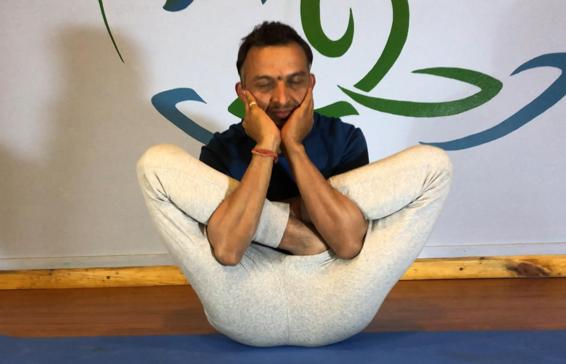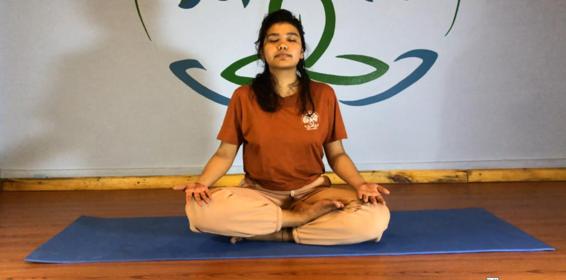4.1 Asana
Asana is a term used in yoga to refer to physical postures, or poses. Asanas are an important part of most styles of yoga and are designed to improve flexibility, strength, and balance. It is believed there are 4.8 million species in the world and there are same no of postures in existence. Belief is only the lord Shiva knows them all, as he is the creator of yogic science. Human is not capable to comprehend it with limited mind.
That’s why yogis have brought it down to eighty-four postures. Where eighty are dynamic postures and four are static pose. Which are also known as meditation pose.
Actual purpose of Asana is to make one eligible to sit in meditation for a longer period of time.
There are many different types of asanas, ranging from standing poses to seated poses, prone and supine poses to inverted poses. Some common standing asanas include Warrior Pose, Triangle Pose, and Tree Pose. Seated asanas include Lotus Pose, Seated Forward Bend, and Child's Pose. Inverted asanas include Shoulder Stand, Headstand, and Handstand etc. Each asana has its own unique benefits, and the practice of asanas can help to improve posture, reduce stress, and increase overall physical and mental well-being.

In a yoga class, you can expect to practice a variety of asanas, and the sequence of asanas may vary depending on the style of yoga being taught. Some styles of yoga, such as Ashtanga yoga, follow a set sequence of asanas, while others, such as Vinyasa yoga, involve the creation of a flow of movement between asanas. Hatha yoga demands you to hold the posture for longer period.
It is important to find a qualified yoga teacher who can guide you through the practice of asanas and help you to improve your alignment and technique. With regular practice and the guidance of a qualified teacher, the practice of asanas can be a powerful tool for improving physical and mental well-being.
In addition to the physical benefits of asana practice, asanas can also have mental benefits, as they help to improve focus and concentration and to reduce stress and fatigue. With regular practice, asanas can help you to lead a happier, healthier life.
It is important to listen to your body and modify the practice of asanas as needed to ensure that you are comfortable and safe. If you are new to the practice of asanas, it is a good idea to start with a gentler style of yoga, such as Hatha yoga, and to work with a qualified teacher to ensure that you are practicing safely and correctly. When alignments are not maintained or proper warm up doesn’t happen then it may lead to muscle catch and other injuries. So, one needs to be under the guidance of competent master.
As you become more familiar with the practice of asanas, you may choose to explore more challenging styles of yoga, such as Ashtanga or Bikram yoga. No matter what style of yoga you choose, it is important to listen to your body and to respect your limits.
With regular practice and the guidance of a qualified teacher, the practice of asanas can be a powerful tool for improving physical and mental well-being.
4.2 Pranayama
Pranayama is a term used in yoga to refer to breathing techniques. Pranayama means extension of life force or vitality. Pranayama is an important part of yoga and is designed to calm the mind and improve focus and concentration along with increasing the vital force.
There are many different types of pranayama techniques, ranging from simple deep breathing exercises to more advanced techniques such as alternate nostril breathing with retention. Some common pranayama techniques include: 6. Deep breathing: Deep breathing, also known as diaphragmatic breathing or belly breathing, involves taking slow, deep breaths through the nose and exhaling through the mouth. To practice deep breathing, start by finding a comfortable seated position with your back straight and your feet planted firmly on the ground. Place one hand on your stomach and the other hand on your chest. As you inhale, focus on filling your belly with air, and as you exhale, focus on releasing the air slowly through your mouth.
Deep breathing can help to calm the mind and improve focus and concentration.
7. Alternate nostril breathing: Alternate nostril breathing, also known as anuloma viloma, involves alternating the breath between the right and left nostrils. To practice alternate nostril breathing, start by finding a comfortable seated position with your back straight and your feet planted firmly on the ground. Place your right hand in front of your face, with your index and middle fingers resting between your eyebrows and your thumb and ring finger resting on either side of your nose. Close your right nostril with your thumb and exhale through your left nostril. Inhale through your left nostril, then close your left nostril with your ring finger and exhale through your right nostril. Inhale through your right nostril, then close your right nostril with your thumb and exhale through your left nostril. Continue to alternate your breath in this way for several rounds. Alternate nostril breathing can help to balance the nervous system and improve focus and concentration.
8. Ujjayi breath: Ujjayi breath, also known as ocean breath or victorious breath, involves constricting the throat slightly to create a hissing sound as you exhale. To practice Ujjayi breath, start by finding a comfortable seated position with your back straight and your feet planted firmly on the ground. Place your hands on your knees and close your eyes.
Inhale through your nose, then exhale through your nose while constricting the back of your throat slightly to create a hissing sound. Ujjayi breath can help to calm the mind and improve focus and concentration.
9. Kapalabhati breath: Kapalabhati breath, also known as skull shining breath, involves rapid exhalations through the nose. To practice Kapalabhati breath, start by finding a comfortable seated position with your back straight and your feet planted firmly on the ground. Place your hands on your knees and close your eyes. Exhale rapidly through
your nose, allowing the breath to be expelled naturally on the inhale. Repeat this process for several rounds. Kapalabhati breath can help to improve respiratory function and stimulate the digestive system.
It is important to find a qualified yoga teacher who can guide you through the practice of pranayama and help you to improve your technique. With regular practice and the guidance of a qualified teacher, pranayama can be a powerful tool for improving physical and mental well-being. In addition to its physical benefits, pranayama can also have mental benefits, as it helps to calm the mind and improve focus and concentration.
Online Resources:
Bhramari Pranayama is a yogic breathing technique that involves deep inhalation followed by a prolonged exhalation with a humming sound. It is also known as the "Bee Breath" due to the humming sound resembling the buzz of a bee. This practice is believed to calm the mind, reduce stress and anxiety, improve concentration, and promote overall well-being. It is often used as a form of meditation or relaxation, and is considered to be a simple and effective technique that can be practiced by people of all ages and levels of experience.






